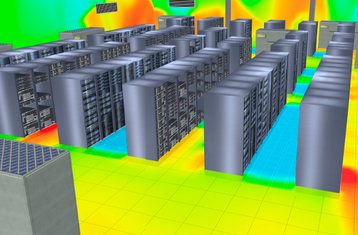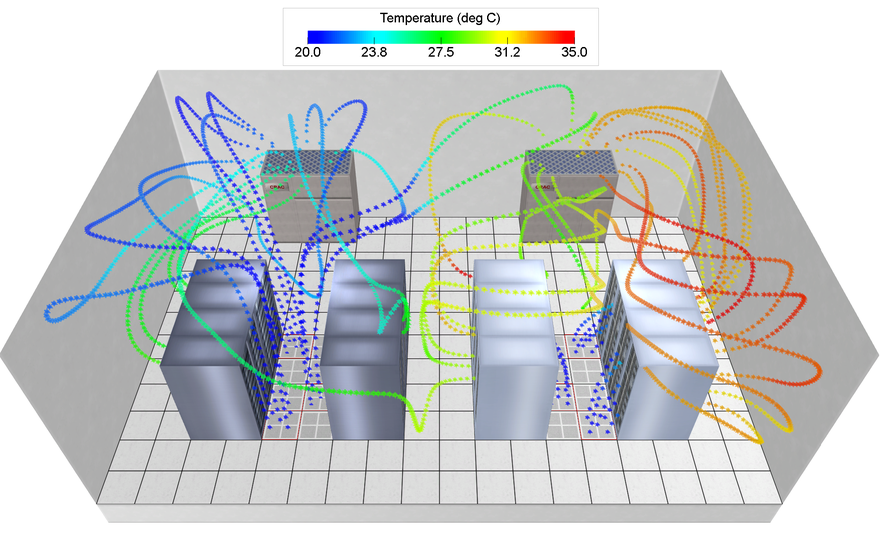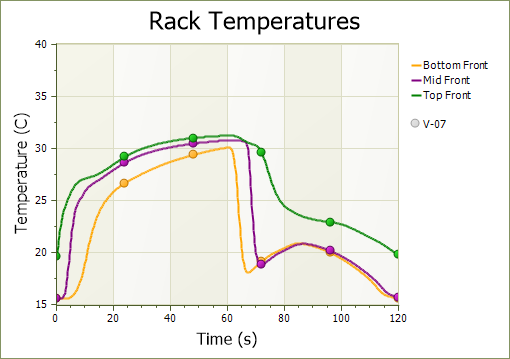Tileflow is a software tool employing the CFD method for creating digital twins and optimizing the cooling performance of data centers. We will be showcasing the latest version of Tileflow at DCD>Connect, London 2024.
Data centers require uninterrupted, zero-downtime operation. To ensure this, the electronics within the IT equipment must be cooled and kept at an acceptable temperature level. An efficient cooling strategy that guarantees acceptable inlet temperature to electronic devices and requires minimum cost presents a difficult challenge. Tileflow offers a scientific approach to meeting this cooling challenge.
The design of an efficient and effective cooling system involves a multitude of decisions, from the design stage to the deployment stage to the normal operation stage, and finally to the emergency operation stage. These decisions include:
- Design Stage: Important decisions need to be made about the geometry of the room, airflow delivery method, type of cooling system, arrangement of racks and cooling units, and usage of airflow barriers such as containments.
- Deployment Stage: For most data centers, IT equipment will be deployed at various stages while the cooling system is designed for full capacity. At each stage, the airflow and cooling demand of the equipment must be met.
- Operation Stage: During the operation of a data center, it is not uncommon to have departures from the design parameters. The departures include changes in rack heat loads, temporary failure of cooling units, and deployment of new cooling strategies such as fan-assisted tiles, partitions, and containments. Is the cooling system still adequate for the changed conditions? If not, what changes are required?
- Emergency operation stage: The data center may experience power or cooling failure. It is vital to keep the operating temperature of IT equipment within the acceptable range while power/cooling is being restored.
Tileflow Digital Twin provides a user-friendly, fast, and accurate procedure for designing data centers, understanding cooling performance, and providing guidance for making changes. It can simulate all data center designs and cooling strategies including raised-floor and slab-floor data centers, down-flow and up-flow CRAH/CRAC units, overhead ducts, fan-wall units, in-row coolers, rear-door heat exchangers, free cooling, etc.
Some of the benefits of using Tileflow are:
- Reducing Design, Construction, and Installation Expenses
- Optimizing Airflow Distribution and Cooling Resources
- Reducing Energy Consumption and Operating Cost
- Increasing System Cooling Capacity
- Improving Response to Cooling Failure
Here, we describe three important and unique features of Tileflow.
Innovative calculation scheme for raised-floor data centers. Tileflow uses an innovative two-domain approach for raised-floor data centers. This approach significantly reduces the calculation time compared with an approach that treats the entire data center as a single domain. The data center is divided into two domains—an under-floor space and an above-floor space—that are coupled. For a large majority of data centers, the pressure variation above the raised floor is small compared with the pressure drop across the perforated tiles. With this assumption, the flow pattern and pressure distribution below the raised floor and the airflow rates through the perforated tiles can be calculated by limiting the calculations to just the under-floor space. The depth of this space is small, so the calculation time is very modest—usually a few minutes. Thus, for most raised-floor data centers, users can perform many under-floor calculations very quickly to get a satisfactory distribution of airflow through the perforated tiles before going to the more involved above-floor calculation. Tileflow checks the validity of results. If needed, it automatically performs the coupled under-floor and above-floor calculation, which accounts for the effect of above-floor pressure variations on the airflow rates through perforated tiles.
Treatment of containments. Containments are an effective means for separating hot and cold air, achieving the desired inlet temperature of servers, and reducing energy consumption and operating costs. For a containment solution to be effective, the pressure on the cold side of racks should be higher than the pressure on the hot side. If this condition is not met, hot air will leak into the cold aisle and increase the inlet temperatures of servers. Moreover, the airflow rates of servers could drop significantly below the designed values. Tileflow accounts for the air leakage through racks and containment walls and the effect of external pressure differences on the server air flow rates. It, thus, empowers users to evaluate the performance of containment solutions at both the design and operation stages.
Power Failure and Transient Calculation. In data centers, servers are usually connected to an uninterruptible power supply (UPS). Thus, in case of a power failure, servers continue to work and generate heat, but the cooling infrastructure may experience full or partial power failure. For the servers to continue working while power/cooling is being restored, their inlet temperatures must be kept below a critical temperature. Tileflow is capable of performing transient calculations and simulating the power failure and restart stages. It accounts for the thermal capacitance of servers/racks and cooling units, fans/chillers decay/restart time, and fan/chillers decay/restart profile. This transient calculation capability allows users to plan for power failure and calculate the time it takes for IT equipment to reach the critical temperature.
To learn more about Tileflow, visit www.tileflow.com
More about DCD>Connect London
-

DCD>Connect | London - Buyer Intent Guide
Explore the procurement needs of over 2,000+ buyers actively seeking new technologies, advisory & third party services
-

In-Person Event Connect | London 2024
-




